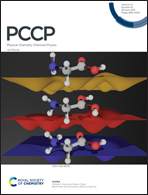Tunable electronic properties of BSe–MoS2/WS2 heterostructures for promoted light utilization†
Abstract
With applications in high performance electronics, photovoltaics, and catalysis, two-dimensional (2D) transition metal dichalcogenides (TMDCs) attract extensive attention due to their extraordinary physical properties. People have focused on TMDC-based materials for years, while the low mobility greatly hinders their further application. TMDC-based heterostructures with tunable band alignment have been experimentally confirmed to be feasible for photoelectronic devices or photocatalysts. Based on the density functional theory (DFT), there are four discoveries in this work: (1) we propose two new heterostructures based on BSe and MoS2/WS2 that have quite low mismatches and intrinsic type-II alignments. (2) Even though the VBM of BSe–MoS2 are completely contributed by BSe, the heterostructure is still endowed with a lower effective mass and a better transport characteristic in comparison with pristine structures. (3) A promoted absorption ability and a better transport characteristic oppose each other and the two characteristics cannot be obtained at the same time. (4) Tension strained structures can induce promoted light absorption in the solar spectrum and the predicted efficiency of the BSe–MoS2 bilayer can be as high as ∼19.3%, when the external electric field is applied. This theoretical survey proves that BSe–MoS2/WS2 with high flexibility and tunability are potential candidates for novel electronic devices and photocatalysts.



 Please wait while we load your content...
Please wait while we load your content...